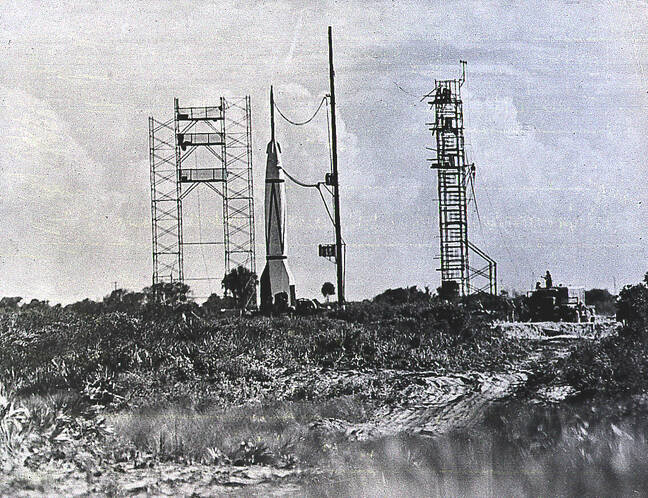It is 75 years since the first rocket launch from Cape Canaveral: a two-stage rocket consisting of a German V-2 missile and a US sounding rocket.
The system, dubbed the “Bumper V-2,” was launched from Cape Canaveral on July 24, 1950.
The first six Bumper flights had been conducted from the White Sands Proving Ground in New Mexico, eventually reaching a speed of 5,000 mph and an altitude of more than 244 miles. However, Florida would provide engineers with a site offering a far greater horizontal range over water.

A Bumper WAC awaits launch (pic: NASA/MSFC)
The program began in 1947 and was intended to demonstrate a two-stage rocket, with separation occurring at high speed. The plan was also to set altitude and velocity records, which was achieved in New Mexico, but not replicated in Florida.
The first stage was the V-2 missile, developed by Nazi Germany during the Second World War.
The second stage, placed atop the missile, was a scaled-down version of a Corporal sounding rocket. Called the WAC (an acronym that might have stood for “Without Attitude Control,” according to NASA), the Corporal was the first operational sounding rocket developed in the US.
Although the idea of a multistage rocket was not new, the program would test the concept with varying degrees of success.
Bumper 7 was initially scheduled to be launched on July 19, 1950, and was prepared for liftoff. However, it took nine hours longer than planned to fill the V-2 part of the system with liquid oxygen. One consequence was a valve failure due to the humid Florida air and a swap with Bumper 8, which became the first rocket to launch from Cape Canaveral.
Unfortunately, the launch did not go as planned. The V-2 lifted off normally, but, according to NASA, “the missile heeled over to 10 degrees instead of the planned 22 degrees.” The result was more strain on the second stage than planned, which separated but failed to ignite.
Engineers tried again on July 29, 1950, with Bumper 7, which went a little better. The V-2 flew a lower trajectory than intended, but at least this time the second stage separated and fired its engines, even if it only reached 3,200 miles per hour.
While the Bumper program at Cape Canaveral was not a storming success, it was the first time a rocket was launched from the facility, paving the way for the thousands that have been launched since.
The facility itself, Launch Complex 3 (LC-3), has long been abandoned and was recently uncovered by students and archaeologists working at the site. While little of the facility remains, the researchers uncovered the floor of the blockhouse and the remains of a Marston’s mat (perforated planking). ®
